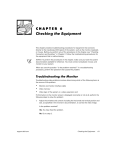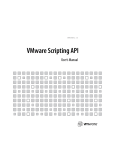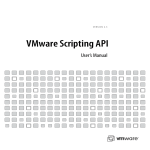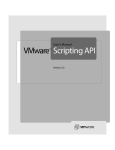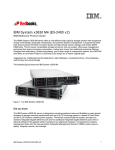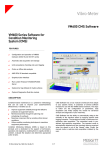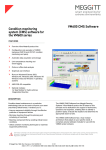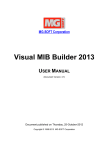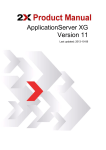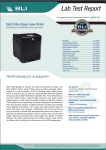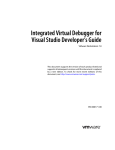Download SYSTEMS MANAGEMENT
Transcript
WHITE PAPER SYSTEMS MANAGEMENT VMWARE WHITE PAPER Systems Management This technical white paper provides an overview of the systems management options possible with VMware ESX Server 2. It is intended as an introduction to ESX Server management capabilities for system planners, system administrators, and system integration professionals who plan to integrate ESX Server into a management infrastructure. This paper provides answers to the following questions: • How is managing ESX Server different from managing a normal server? • What interfaces are available for systems management? • What are the capabilities of each of these interfaces? • What are the management integration approaches for ESX Server? This paper does not describe integration steps for any specific systems management products. Table of Contents • About Systems Management About Systems Management The typical enterprise uses a wide variety of software packages to manage its computing infrastructure. In most companies, enterprise management frameworks such as IBM Director and HP Insight Manager sit side by side with point management solutions for system, security, network and storage management. In addition to the company’s enterprise framework, there are application and device-specific management solutions. Finally, between the enterprise framework and the point management solutions are the programs and scripts that integrate all these components into a coherent set of tools. The key mission of the tool set is to enable the IT manager to guarantee a stable and performing computing infrastructure. An enterprise’s systems management software is a major part of this set of tools. Systems management software provides three essential, generic services across the range of servers, operating systems, and applications that it manages: • Management Architecture • Installation, configuration, upgrade, repair and retirement of software and servers • How ESX Server is different • Performance/fault monitoring and management • ESX Server Management Interfaces • Resource usage metering for planning and billing purposes • Integration with existing system management packages • Future Directions Management Architecture Traditionally, systems management products have had a threecomponent architecture. They have consisted of: • Proprietary management agents installed on the managed server/system • A systems management application that aggregates agent data • A graphical user interface that provides user access and control Management agents typically gather information and perform actions on the operating systems and applications they are managing by using public or private APIs exposed by the managed elements, or by watching well-known files such as the syslog on Linux or various event logs on Windows. The systems management interface typically has an extensible graphical user interface that can easily incorporate new datatypes collected or monitored by agents. However, the ability to perform application-specific management actions is typically not easy to add to the management package since management actions vary so widely across software packages. 1 VMWARE WHITE PAPER How ESX Server is different ESX Server has more components than a simple server running a single operating system. Management and monitoring must be performed at different levels on different components. These correspond closely to the levels in the ESX Server architecture itself: Level 1. The operating system and the applications running inside the virtual machines. Level 2. The configuration and manipulation of the virtual machines themselves. Level 3. The logical view of resources on the physical server, such as CPU utilization, memory utilization, disk bandwidth, and network usage. Level 4. The actual hardware on the physical server. The first and fourth levels can be found commonly on any server system, but the second and third levels are unique to ESX Server; it therefore specifically provides management interfaces for these. The next section describes the interfaces. ESX Server Management Interfaces VMware ESX Server has three types of management and monitoring interfaces that can be leveraged to integrate ESX Server with an enterprise’s systems management software: • The VMware Management Interface, a Web-based graphical interface to monitor and manage ESX Server and its virtual machines directly. This is also the general purpose user interface for ESX Server. • Management APIs in Perl and COM to support scripting of routine ESX Server management functions and to support integration with proprietary management applications and agents. The management interface offers a set of systems management functions for monitoring and resource control and for management of ESX Server and its virtual machines. It also offers unique functions related to setup, configuration, control and provisioning of server resources to virtual machines. In addition, the remote console allows users to connect to virtual machines and manage their state. The management interface is an essential systems management tool for functions specific to ESX Server such as setup, configuration and basic systems management of ESX Server. It provides user-friendly visualization of the current state and resource usage of all virtual machines at a glance. Once ESX Server is deployed in production, customers also have the choice of using their own systems management systems, integrating ESX Server with those systems using ESX Server SNMP interface and Perl/COM APIs. The SNMP Interface and Management Information Base ESX Server ships with an SNMP agent that allows monitoring of the Service Console, including the health of the host machine, as well as monitoring of virtual machines running on the host. The agent is based on Net-SNMP with enhancements to support data specific to ESX Server. The ESX Server SNMP agent can be used with any management software that can load and compile a management information base (MIB) in SMIv1 format and can understand SNMPv1 trap messages. SNMP interfaces are ideal for providing information and status about virtual machines and can be used to communicate this to a systems management agent running in the Service Console or to interface directly with systems management products that can communicate with an SNMP interface. • A detailed SNMP MIB (management information base) which provides configuration and performance information for standards-based integration with enterprise management frameworks such as HP OpenView or IBM Director. The VMware Management Interface The VMware Management Interface is a browser-based interface that provides functionality specific to ESX Server such as: • Basic system setup and configuration • Creation and provisioning of virtual machines • Monitoring and control over virtual machines • Configuration of resource management settings for virtual machines • A remote console for interactive control of each virtual machine 2 VMWARE WHITE PAPER System Information SNMP Traps Sent by the SNMP Agent SNMP ‘get’ variables allow users to monitor a variety of items about the host computer and how virtual machines are using host resources. Some of the key types of information are: Four SNMP traps notify users of critical events in particular virtual machines. The traps are sent: System State - The number of CPUs on the host computer - When a virtual machine is powered off - The amount of RAM installed on the host computer - Information on whether ESX Server is loaded or not System Resource Usage - Host memory used by the Service Console - Host CPU resources being used by particular virtual machines - When a virtual machine is powered on - When a virtual machine detects a loss of heartbeat in a guest operating system - When the virtual machine detects that the guest operating system’s heartbeat has started or resumed For more details on SNMP, including installation and configuration, please see the user’s manual for VMware ESX Server. - Host memory used by particular virtual machines The COM and Perl Scripting API’s - Host memory that is not being used The SNMP interface provides a wealth of information about virtual machines, but it is a read-only interface. To perform management actions on an ESX Server system, and to enable custom integration with systems management agents and applications, ESX Server provides VmPerl and VmCOM Scripting APIs. - Usage data for disks on the host, including number of reads and writes and amount of data read and written - Usage data on the host’s network adapters, including packets sent and received, and kilobytes sent and received Virtual Machine Information SNMP ‘get’ variables allow users to monitor a number of items about virtual machines running on the host. Some of the key types of information available are: Virtual Machine Configuration - The path to the virtual machine configuration file - The guest operating system running on the virtual machine The ESX Server VmPerl is a Perl-based application programming interface that allows control over ESX Server and its virtual machines. This control can be done both locally and remotely across servers. VmCOM is a Component Object Model (COM) interface providing the same management functionality, for use in languages such as Microsoft(TM) Visual Basic(TM), Microsoft(TM) Visual Basic (TM) Scripting Edition (also known as VBScript), Microsoft(TM) Visual C++(TM) and Jscript(TM). - The amount of memory the virtual machine is configured to use The VmPerl API - What disk adapters are seen by the virtual machine The VmPerl Scripting API consists of three packages, VmPerl, VmPerl::Server and VmPerl::VM. - What network adapters are seen by the virtual machine - What floppy disk drives are seen by the virtual machine - What CD-ROM drives are seen by the virtual machine Virtual Machine State - The virtual machine’s power state: on or off VMware::VmPerl This module contains global definitions such as version information and error codes. - The state of the guest operating system: on or off (running or not running) VMware::VmPerl::Server This module is used for programmatic manipulation of ESX Server running virtual machines. Examples of operations provided by this module are: - The state of the floppy drive: connected or disconnected - Connect to a server - The state of the CD-ROM drive: connected or disconnected - List the virtual machines on that server - Create virtual machine objects - Disconnect from the server - Register and unregister configuration files for virtual machines 3 VMWARE WHITE PAPER VMware::VmPerl::VM This module is used for controlling the interaction with virtual machines on a server. Examples of operations provided by this module are: - Connect to a virtual machine - Check a virtual machine’s state - Start, stop, suspend and resume virtual machines - Query and modify configuration file settings - Answer status questions from virtual machines - Get basic heartbeat from a virtual machine - Pass parameters to and from VMware Tools in each virtual machine The VmCOM API Likewise, the VmCOM COM interface exposes VmServerCtl and Vmctl as primary objects for communicating with VMware components. Detailed VmPerl and VmCOM API documentation can be found on the VMware Web site at: http://www.vmware.com/support/developer/ This document also contains useful sample scripts. Integration with other system management packages The ESX Server-specific management interfaces described above are oriented only towards levels 2 and 3 of the ESX Server architectural and system management hierarchy described above. Although there is some overlap in functionality in some places, levels 1 and 4 have been left largely untouched. These levels are managed by existing system management packages. These packages, although sometimes vendor-specific, can be integrated into the ESX Server architecture to complete the solution. Keeping in mind the ESX Server architecture (with multiple operating systems running in virtual machines alongside a Service Console), levels 1 and 4 can be integrated into the management solution as follows: Level 1 — Monitoring status of the operating system and applications inside a virtual machine Install on the operating system inside the virtual machine the management package which you would normally use for monitoring the operating system resources and its applications. If SNMP is the preferred interface for monitoring, install those agents inside the virtual machine. managed as a separate machine with full functionality offered by those agents. However, this requires that agents have no hardware-specific dependencies, e.g., HP agents may not install in the guest operating system because the virtual hardware is not HP-specific. ESX Server itself does not interfere with the applications running inside a virtual machine’s guest operating system. Level 4 — Monitoring the physical hardware of the physical server. Existing vendor-specific hardware monitoring agents can be installed on ESX Server to provide this functionality. These agents are typically installed on the ESX Server Service Console, which is based on RedHat Linux. Compatible management software for ESX Server This section outlines the system management packages which have been tested with ESX Server. Each is followed by a brief description of its capabilities and how it is typically integrated with ESX Server 2.x. For the exact versions of the management software that have been tested with the latest release of ESX Server please refer to ESX Server Systems Compatibility Guide, located at: http://www.vmware.com/pdf/esx_systems_guide.pdf IBM Director The IBM Director suite consists of agents which run on the machine to be monitored, which link to a central server that presents the information via the IBM Director client. The IBM agents are installed on the ESX Server Service Console. Although the Director suite does not include an SNMP agent, the client application can communicate with the VMware SNMP agent to obtain VMware MIB items. Additionally, IBM agents can be installed in the guest operating systems of virtual machines, making them first-class manageable objects in the IBM Director suite. HP Insight Manager The HP Insight Manager/Agents package consists of several monitoring agents from which information can be viewed through three interfaces: Web, SNMP, and the Insight Manager application. The HP Insight Agents are installed on the ESX Server Service Console. The HP SNMP agent and the VMware SNMP agent interoperate to provide items from both MIBs through the HP SNMP agent. HP agents cannot be installed inside guest operating systems of virtual machines. The HP In this configuration, each operating system running in a virtual machine has its own agent that communicates directly with the systems management application. Each virtual machine is 4 VMWARE WHITE PAPER Openview client has been tested for viewing VMware SNMP MIB items independently of other HP agents. below shows what the different agents are able to detect and monitor when installed on ESX Server. Future Directions Dell OpenManage The Dell OpenManage agents export data through Web and SNMP interfaces. These agents are installed on the ESX Server Service Console. VMware MIB items are exported through the Dell SNMP agent. SNMP traps are generated by both Dell and VMware SNMP agents. Dell health agents cannot be installed inside guest operating systems of virtual machines. The table CPU Dell Storage All modules at hardware level; memory for Service Console Disks: all Controllers: ServeRaid Service Console NIC only Detect all; diagnose Service Console All modules at hardware level; memory for Service Console All All Detect all; diagnose Service Console All modules at hardware level All Service Console NIC only * Applies to the IBM Director interface that does not use the Service Processor. Information obtained from the Service Processor is no different on ESX Server than other systems. 5 Network All IBM* HP Memory In future product releases, ESX Server may provide even greater systems management capabilities. Areas we are exploring include newer versions of the Perl and COM API’s with greater functionality, and deeper integration with enterprise management frameworks and vendor-specific systems management tools. ������������������������������������������������������������������������������������������������������� ������������������������������������������������������������������������������������������������������������������������� ����������������������������������������������������������������������������������������������������������������������� �������������������������������������������������������������������������������������������������������������������� �������������������������������������������������������������������������������������������������������







